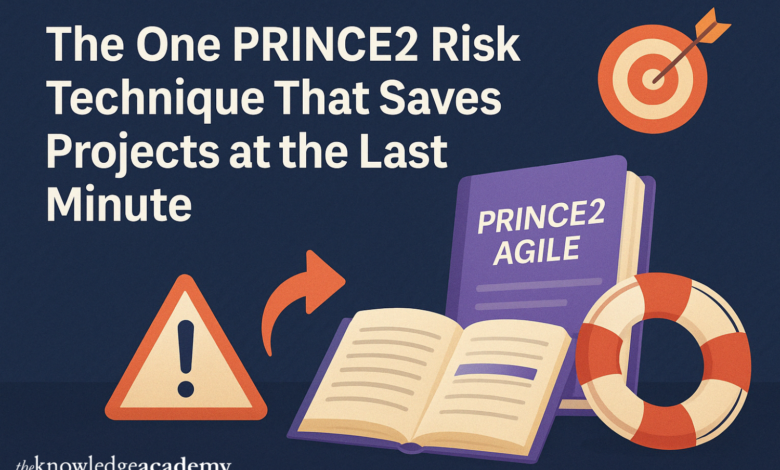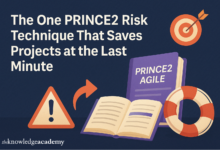The One PRINCE2 Risk Technique That Saves Projects at the Last Minute

What is your next move when a project teeters on the brink of failure? Deadlines are closing in, budgets are stretched thin, and unexpected risks are turning up uninvited, a scenario even experienced managers dread. This is where mastering the proper techniques becomes vital.
Many professionals turn to the PRINCE2 Agile Foundation and Practitioner Course to build that safety net, learning to stay calm when chaos strikes. One standout skill is practical PRINCE2 Risk Management, offering a structured way to regain control when things go off track. Let’s explore how this single technique can rescue your project when it matters most.
Table of Contents
- Understanding Risk Management in PRINCE2
- The Magic of the ‘Fallback Plan’
- Why This Technique Works Under Pressure
- Applying the Fallback Plan: A Quick Guide
- Conclusion
Understanding Risk Management in PRINCE2
According to PRINCE2, risk management is not merely an afterthought but a fundamental component of project success. Project managers are urged to identify, evaluate, and control risks. However, surprises can still occur even with the finest preparation. Reactive tactics are used in this situation.
PRINCE2 recognises that you cannot forecast everything, in contrast to frameworks that strongly emphasise prevention. It ensures you are not left rushing at the last minute by providing valuable tools in case things go wrong. At the core of this lies a method that is often overlooked: the Fallback Plan.
The Magic of the ‘Fallback Plan’
So, what is the Fallback Plan? To put it simply, it’s your safety net. A fallback plan responds to the question, “What will we do if it happens anyway?” whereas mitigation techniques work to lessen the likelihood that a risk would materialise.
Due to this proactive thinking, teams can remain composed in the face of problems like supplier failures, technical difficulties, or the loss of vital resources. The fallback plan, which is pre-approved, budgeted, and prepared, takes over in an emergency rather than wasting valuable time determining what to do next.
Many project managers attribute their projects’ success to this strategy when unforeseen hazards materialise. Being ready to respond quickly and forcefully when issues occur is more critical than avoiding them altogether.
Why This Technique Works Under Pressure
When a project is under strain, decision-making often degrades. Teams become anxious, communication breaks down, and rash decisions result in expensive errors. The fallback plan is brilliant because it eliminates emotion from the equation.
When stress levels are at their highest, fallback actions offer clear direction since they are prearranged. Everyone understands their roles, what has to be done, and how it will impact the objectives of the project. This openness reduces conflict, eliminates delays, and usually helps to rebuild stakeholder confidence even in trying conditions.
The versatility of this approach adds another element supporting its success. Depending on the complexity of the project and risk tolerance, your backup plans could be simple or complicated as required since PRINCE2 promotes customisation.
Applying the Fallback Plan: A Quick Guide
Understanding fallback strategies is one thing but putting them to good use is another. Here’s how to use the PRINCE2 methodology to protect your projects:
- Identify Risks Early: During the risk assessment stage, highlight high-impact hazards where mitigation may not be sufficient. These are excellent options for contingency preparation.
- Define Clear Triggers: Indicate the circumstance or occurrence that will activate the fallback plan. This avoids uncertainty about when to move from mitigation to action.
- Get Stakeholder Approval: Ensure backup plans, related expenses, and deadlines are approved beforehand. When time is of the essence, this avoids execution delays.
- Communicate Across Teams: Ensure all participants know the strategy and their roles. A knowledgeable workforce responds more quickly and efficiently.
- Review and Update Regularly: Just as risks change, so should your backup plans. Plan frequent reviews to maintain their applicability and relevance.
Incorporating this strategy into your risk management procedure will prepare you for the worst-case scenario without letting it throw your project off course.
Conclusion
Uncertainty is a part of every project, but how you handle it determines its success. When the unexpected happens, the PRINCE2 fallback plan provides a strategic advantage rather than merely a backup. Consider taking courses from The Knowledge Academy to improve your project risk management skills and stay ahead of the curve in every project.

